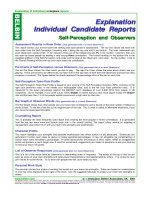Macroeconomics report
Bạn đang xem bản rút gọn của tài liệu. Xem và tải ngay bản đầy đủ của tài liệu tại đây (785.22 KB, 23 trang )
TABLE OF CONTENTS
CATALOGUE OF SYMBOLS AND ABBREVIATIONS..........................................2
PICTURE BIBLIOGRAPHY......................................................................................2
PROLOGUE................................................................................................................2
1.Reasons for choosing the topic.............................................................................3
2.Research objectives:.............................................................................................4
3.Subjects and scope of research:...........................................................................4
4.Research Questions...............................................................................................4
5.Research methodology:........................................................................................4
6. Structure of the topic...........................................................................................5
CHAPTER I: JAPAN'S GROWTH THROUGH THE AGES....................................5
1.1990-1999: Japan experienced a lost decade.......................................................5
1.1. Consequences when the economic bubble deflats.......................................5
1.2. Causes of the recession:.................................................................................6
1.3. Policies applied for this period:....................................................................8
2. 1999-2007: Moderate recovery and growth.....................................................10
2.1. Action Plan for Economic Growth:............................................................10
2.2. Loose monetary policy:...............................................................................12
3.2007-2012: Impact of the world financial crisis................................................13
3.1. Impact of the financial crisis on the Japanese economy...........................13
3.2. Government policies....................................................................................15
4. 2012-2018: Economic growth flourished under Prime Minister Shinzo Abe 16
4.1. Abenomics Stimulus Package.....................................................................16
4.2. Impacts of policies on economic growth....................................................18
4.3. Difficulties in implementing the policy.......................................................20
4.4. US-China trade war.....................................................................................20
5. 2018-2020: Impact of Covid-19:........................................................................21
5.1. Policies issued...............................................................................................21
5.2. Impact on the economy...............................................................................21
CHAPTER 2: LESSONS LEARNED FOR VIETNAM...........................................23
1. Lessons learned for successful development:...................................................23
2. Lessons learned to avoid recession impacts:....................................................23
CONCLUDE..............................................................................................................23
BIBLIOGRAPHY......................................................................................................24
1.Domestic documentation....................................................................................24
2.Foreign documents..............................................................................................24
CATALOGUE OF SYMBOLS AND ABBREVIATIONS
BOJ
Bank of Japan
GDP
Gross Domestic Product
CPI
Consumer Price Index
PICTURE BIBLIOGRAPHY
Figure 1. Japan entered the recession of 1990-1999
Figure 2. Deflationary model and its impact
Figure 3. Tightening monetary policy
Figure 4. Expansionary monetary policy.
Figure 5. The impact of fiscal policy on aggregate demand.
Figure 6. Japanese interest rates in the period 1980-2013.
Figure 7. Japan's economic growth from 2007 to 2012
Figure 8. Consumer Price Index CPI 2004-2012.
Figure 9. The impact of the policy on the Japanese economy
Figure 10. Loose monetary policy
Figure 11. Expansionary fiscal policy
Figure 12. Japan's inflation over time.
Figure 13. Real GDP (Thousand yen) 2018-2020
PROLOGUE
Japan's economic growthin the period from 1990 to 2020 is a topic of much interest and
analysis. This period, often referred to as the "Lost Decades," was characterized by a significant
slowdown in Japan's economic growth compared to the boom years of the 1980s. It was a
challenging era for the Japanese economy, marked by numerous structural changes, financial
crises, and demographic changes that had a profound impact on the nation's growth trajectory.
The 1980s saw Japan's remarkable rise as an economic powerhouse, with rapid
industrialization, technological progress, and strong export-oriented growth. However, the bubble
economy that fueled this extraordinary expansion burst in the early1990s, leading to a prolonged
period of economic stagnation and deflation. This marked the beginning of Japan's economic
challenges and set the stage for the next years of slow growth.
Between 1990 and 2020, Japangrappled with a number of structural problems that hampered its
growth potential. A key factor is the country's aging population and low birth rate, which has led
to a shrinking workforce and increased strain on social welfare systems. In addition, Japan faces
increasing competition from emerging economies, such as China and South Korea, which are
beginning to gain traction in the global market. These dynamics further complicate Japan's efforts
to restart its economic engine.
The government has implemented various policies and strategies to combat economic
stagnation. It pursues aggressive monetary easing, fiscal stimulus packages, and structural
reforms aimed at reviving growth, improving corporate governance and promoting innovation.
These measures are designed to address issues such as the zombie company phenomenon,
inefficient resource allocation and a rigid labor market, among others.
The study aims to provide a comprehensive analysis of Japan's economic growth between
1990 and 2020, examining the key factors, challenges, and policy responses that have shaped its
trajectory. By looking atmacroeconomic indicators, such as GDP growth rate, inflation,
unemployment rate, and productivity, we can better understand the overall performance of the
Japanese economy. Furthermore, we will delve into specific sectors and industries that emerge as
driversor barriers to growth, explore the impact of globalization, technology, and changing
consumer preferences.
Understanding Japan's economic growth during this period is crucial not only for economists
and policymakers but also for investors, businesses, and individuals seeking to understand the
long-term implications of these developments. By examining the successes and failures of Japan's
growth strategies, we can drawvaluable lessons that can inform future economic policies and
provide insights into potential pathways for sustainable growth in the face of growing global
challenges.
1.Reasons for choosing the topic
1.1. Learn from the world's leading country: From the factors that affect economic growth, the
policies that this government implemented in the period 1990-2020 can help us better understand
Japan's failures and successes. Thereby, we can draw important lessons and apply them to
economies other, especially in the Vietnamese economy
1.2. Economic Policy Direction: This study provides important information for economic policy
leaders as well as governments to guide and adopt appropriate measures to promote economic
growth and mitigate risks.
1.3. Understand Economic Development and Structural Challenges: This study helps us better
understand Japan's economic development process and structural challenges.
2.Research objectives:
First, understand how Japan's economy operates in the period 1990-2020
Second, analyze the policy implications that the country has used to overcome recessions and
economic growth.
Third, draw lessons learned for countries around the world in general and Vietnam in particular.
3.Subjects and scope of research:
Object of study: Japan's Economic Growth
Scope of research:
-
Space: Japan
-
Period: 1990-2020
4.Research Questions
-
What was Japan's economic growth like in each period 1990-2020?
-
What macro policies has the Japanese government used to run the economy?
-
What impact do these policies have on the Japanese economy?
-
What lessons are learned when learning about the "rising sun" country?
5.Research methodology:
-
Data collection and analysis
-
Compare
6. Structure of the topic
Chapter 1: Japan’s growth through the ages
Chapter 2: Lessons learned for Vietnam
CHAPTER I: JAPAN'S GROWTH THROUGH THE AGES
1.1990-1999: Japan experienced a lost decade
1.1. Consequences when the economic bubble deflats
The economic bubble occurred for about 4 years, from 1986 to 1991 in Japan with asharp
escalation in land prices and stock prices. The rise in the price of these asset classes makes many
individuals and companies rich in an instant. Production and spending have been stimulated,
causing economic growth to leapfrog. But the subsequent collapse was as rapid as its initial
intense swelling, so it was associated with the name bubble.
The collapse of the "bubble economy" in the early 1990s put severe pressure on Japanese
financial institutions and reduced consumer spending incentives and reduced business investment.
Many Japanese banks face debt burdens. Meanwhile, the Tokyo Stock Exchange took a rapid
downturn in stock values.
The period of the 1990s, which saw stagnant economic growth, marked the beginning of the
lost decade following the collapse of Japan's asset price bubble.
Figure 1. Japan entered the recession of 1990-1999
Since 1990, Japan's economic growth has seemed to enter a new turning point. Economic
growth in this period is like a sinusoidal graph, unstable growth, even periods of recession to
negative growth like in 1998-1999. Theaverage annual real GDP growth rate for the period 19912000 was only 0.5% - much lower than in previous periods.
With high government public debt, Japan ran large budget deficits (adding trillions of yen to
the Japanese financial system) to fund massive public programs. However, these works did not
achieve the expected benefits. At the same time, the pressure of the economy caused a series of
companies to fall into bankruptcy.
In 1998, after somemacro-policy adjustments, Japan fell into deflation again, negative for the
first time in 23 years. Simply put, deflation is a situation in which the price of goods becomes
relatively cheaper. This givesconsumers a key way of thinking, wait for prices to get cheaper
before buying goods (consumer spending C decreases).At the same time, deflation causes
inflation expectations to fall, leading to increased real interest rates, leading to barriers to private
sector investment (I decrease).
Figure 2. Deflationary model and its impact
1.2. Causes of the recession:
1.2.1. Due to the deflating of the bubble economy:
The deflating of the economic bubble has created enormous pressure, especially on Japanese
financial institutions. The fear of a recession, unsafe economy has made businesses dare not
invest directly, but have apprehension and caution (I decreased), consumers also lose their
spending motivation (C decreases).
1.2.2. Excess production capacity:
First, industrialization and exports: Japan has experienced a period of intense industrialization
and development of its export industry at an earlier stage, especially in areas such as automobiles,
electronics and machinery. However, the rapid development ofindustrial power has led to
production capabilities exceeding demand in some sectors.
The second is oversupply and demand decline: The economic slowdown and reduced
consumption during this period caused an oversupply of goods in the Japanese economy.
Products of industries, especially traditional industrial products, has exceeded actual demand and
led to inventory buildup. At the same time, in the 1980s, Japan invested heavily in new
machinery and equipment, leading to a recession where businesses had difficulty dealing with
backlogs.
The third is a decline in growth and a decline in investment: During an economic downturn, a
decline in growth and a decline in investment has increased the likelihood of excess production.
Enterprises have reduced investment in new production lines and scaled up operations due to
financial difficulties and lack of economic incentives.
1.2.3. The appreciation of the yen:
After the signing of the Plaza Accord with the US, the consequences of the bubble deflating
caused the yen to skyrocket (e rise). The yen's appreciation has reduced the competitive priceof
Japanese goods in relation to those produced by foreign firms. In terms of purchasing power
(PPP), the value of the yen is too high compared to its actual value. When the price of the local
currency becomes higher, i.e the price of domestic goods becomes more expensive relative to
foreign goods. The decline in domestic exports caused the trade balances (net exports) to fall
sharply. At the same time, the weakness and backwardness of the banking and financial system:
Japan's banking and financial system, which is strictly controlled by the government, is no longer
suitable for the conditions of science and technology and free competition.
1.2.4. Labor market:
Japan's labor market began to fall into an ageing population, in 1990-2000, resource growth was
only 0.36%. Low resources, not only make businesses scarce workforce, leading to high wages
for workers, but the government also has to pay additional pensions and social benefits for the
elderly. Moreover, many businesses are seriously affected by the lack of the most important
production resource, which is people.
1.3. Policies applied for this period:
After the economic bubble burst. Fearing inflation from the collapse of the housing and stock
markets, the government enacted this policy, drastically reducing the Ms money supply from over
11% (1990) to 0.6% (1991).
Figure 3. Tightening monetary policy
This can control inflation, but tightening the money supply causes the economy to be strangled,
interest rates rise, businesses are hesitant to invest in production, recession begins to occur.
Very quickly the Japanese government realized themistake of its move, but it is still a bit
late compared to the health of the current economy. By the second quarter of 1991, the Japanese
government used expansionary monetary policy to expand the country's money supply,
overcoming the flaws ofprevious policies aimed at raising inflation expectations and boosting
economic growth.
Figure 4. Expansionary monetary policy.
In contrast to tighter monetary policy, increasing the money supply helps lower interest rates,
which stimulatesmore investment and consumption.
In parallel with the adjustments in monetary policy, in 1992, the Japanese government made
changes in fiscal policy. The ZIRP policy reduces interest rates r to near zero, increasing G
investment for public sectors.
Figure 5. The impactof fiscal policy on aggregate demand.
In 1998, however, Japan's public projects were still insufficient in demand to end the economy's
stagnation. In desperation, the Japanese government has undertaken "structural reforms" aimed at
removingexcess investment from the stock and real estate markets. However, it causes prolonged
deflation.
Finally, there are labor policies: Due to population ageing, there is a lack of core production
forces. This forced Japan to overcomethis by importing labor from abroad more cheaply, and
enjoying fewer regimes than native labor.
2. 1999-2007: Moderate recovery and growth
After the failure of macro policies from the previous decade, the Japanese governmenthas
implemented many economic recovery measures. And these policies have provided a new
glimmer of hope for Japan's economy after a decade of recession.
2.1. Action Plan for Economic Growth:
In 1999, the Japanese government published an Economic Growth Strategy aimed at creating
structural economic change and boosting labor productivity. The plan focuses on boosting
technological innovation, boosting public investment, promoting the development of high-tech
industries and boosting exports.
2.1.1. Financial support:
The Japanese government has implemented financial support measures such as providing capital
to commercial banks and other financial institutions toenhance the stability of the financial
system. At the same time, the government also applies measures to encourage home loans and
property investment to stimulate consumer demand and boost investment.
2.1.2. Public investment:
Japan has increased public investment to boosteconomic growth. Public investment projects focus
on improving infrastructure, including transport, electricity, telecommunications, and the
environment. This is to facilitate business activities and enhance the competitiveness of the
economy.
The first is investment in infrastructure: The Japanese government has increased investment
in infrastructure, including transportation, electricity, telecommunications, and environmental
projects. The increase of investment in infrastructure aims to facilitate business activities, attract
foreign investment and improve the competitiveness of the economy.
Second, increased spending on education and research: The government has increased
investment in education and research to improve the quality and productivity of workers. This
includes improving the education system, training high-quality human resources and encouraging
technological research and development.
Third, support for small and medium-sized enterprises: The Japanese government has applied
financial support measures and incentives for small and medium-sized enterprises. This includes
providing capital to small and medium-sized enterprises, facilitating start-ups and scaling
businesses.
Finally, there are social policies: the government has increased spending on social policies
such as health care, social insurance, and support policies for the elderly, people with disabilities
and other people in difficulty. This is to create stability and reduce the burden on households and
enhance social justice.
2.1.3. Investment in science and technology:
Japan has focused on technological innovation efforts to enhance the overall competitiveness
of its economy. The government has increased support for research and development, encouraged
collaboration between businesses and research institutes, and facilitated development.
Comments: Compared to the actual level achieved during the previous high growth period of
10%, economic growth has only remained at 1.5%-2%. However, the economy has prospered
from policies during this period.
Explanation: The Japanese government makes policies that stem from the source of economic
growth. We can rely on the production function to explain this: The production function tells us
the maximum level of output (Y) that the economy can produce with a defined amount of input
and level of technology.
The production functiont takes the form: Y = F (K, L, R, T) when increasing the number of inputs
will increase Y. Japan took advantage of this to enact policies:
K: capital investment, infrastructure, public investment
L: human capital investment, high-quality labor
T: There are policies that promote and alsoadvance technology.
2.2. Loose monetary policy:
2.2.1. Low interest rate policy
The Bank of Japan (BOJ) has maintained low interest rates throughout this period. The goal
is to encourage borrowing and investment by businesses andbusinesses, stimulating the economy.
Figure 6. Japanese interest rates in the period 1980-2013.
2.2.2. Buy government bonds
The BOJ has implemented a policy of buying government bonds in the so-called "sakura
zensen" process. This means that the central bank buys back part of government bonds in the
market, creating increased demand and lowering interest rates. This is to support thefinancial
market, enhance liquidity and create stability.
2.2.3. Expansion of the money supply
The BOJ has stepped up the supply of cash into the financial system. By buying back
valuable bonds and papers, the central bank has increased the supply of currency to banks and
businesses. This enhances liquidity and supports financial and investment activities.
2.2.4. Mass policy
This policy aims to create a favorable credit environment for businesses. Measures such as
deregulation and credit reviews have been implemented to ease the burden on businesses and
facilitate easier lending.
3.2007-2012: Impact of the world financial crisis
3.1. Impact of the financial crisis on the Japanese economy
The crisis in the world has caused difficulties for many countries around the world, and Japan
has also faced many challenges in the face of this shock. Economic difficulties have piled up
since late 2007. This year, inflation stood at 1.2%, a series of businesses and companies went
bankrupt and workers were unemployed.
According to statistics from the Japanese Ministry of Finance, during this period Japan's trade
balance was in deficit. It can be said that the impact of the global financial crisis has made Japan's
foreign trade balance from a huge surplus to a deficitin just 1 year. In particular, exports in fiscal
2008 reached 71.1435 trillion yen, down 16.4% and the largest decline ever. Imports reached
71.8688 trillion yen, down 4.1%. In particular, exports to the US only reached 12.876 trillion yen,
down 27.2% from the previous year, and the largest decrease ever. Exports to European countries
decreased by 23%, and also the 2nd largest decrease compared to the past. Exports to the Asian
market also fell by 13.4%. In which, China's sang exports decreased by 9.8%. Exports to South
Korea and Hong Kong also fell sharply.
The labor market has been hit hard by the effects of the recession: many businesses are cutting
workers. The electronics industry has been most affected byJapan's development, but global
demand has declined. Unemployment rose rapidly. Layoffs by companies combined with
stagnant production have pushed unemployment in Japan to record levels. The total number of
fully unemployed peoplein Japan as of April 2009 reached 3.35 million, an increase of 670,000
people compared to the previous month and the 5th consecutive month of increase. The number
of people working was 62.45 million, down 910 thousand people compared to the same period
last year and the 14th month of continuous decline.
Japan's total export turnover in the first quarter of 2009 decreased by 26% (due to the
decrease in export turnover of automobiles and electronic components). This is also the largest
drop since World War II. In addition, investment in Japanese equipment manufacturing
enterprises also fell sharply. Since the first quarter of 2009, Japan's investment in these
enterprises has fallen to 10.4 percent, also a record decline since World War II.
Figure 7. Japan's economic growth from 2007 to 2012
From the graph we can see: Japan's economic growth decreased gradually over the years during
this period: in 2007 it increased by 1.48%, in 2008 it decreased, even negative growth to -1.22%,
and by 2009, growth fell the most to -5.69%.
Deflation, adecrease in the domestic consumer price index. According to the Bank of Japan's
announcement on July 10, the wholesale price index (CPI) in June 2009 fell by 6.6% year-onyear, which is also the highest price decline in Japanese history. Falling commodity prices
indicateweak domestic demand amid spending curbs and layoffs, making Japan's economic
picture even bleaker.
Figure 8. Consumer Price Index CPI 2004-2012.
3.2. Government policies
To overcome the situation caused by the financial crisis, the Japanese government launched
economic stimulus packages: the first economic stimulus plan worth $ 274 billion. This can be
seen as theexpansionary fiscal policy that Japan has chosen for its suffering economy
In order to revive the sharply depressed economy, Japan's lower house of parliament has also
approved a supplementary budget for fiscal 2009, totaling 13.93 trillion yen. This is the largest
supplementary budget ever in Japan. The supplementary budget includes 1.2 trillion yen for
supporting job creation, about 3 trillion yen for implementing financial measures and 2 trillion
yen for supporting health and child care.
To fund this massive supplementary budget, the Japanese government plans to issue 10 trillion
yen of bonds, bringing the total value of bonds the government plans to issue this fiscal to a
record 44 trillion yen. Along with the first stimulus package, Japan launched the next 3 stimulus
packages. However, it is unclear if future stimulus packages have been rolled out and how they
will be applied.
Comment: Thanks to these stimulus packages, at the end of 2009 the Japanese economy had
positive and optimistic signals.
Figure 9. The impact of the policy on the Japanese economy
4. 2012-2018: Economic growth flourished under Prime Minister Shinzo Abe
4.1. Abenomics Stimulus Package
The term Abenomics is a combination of "Abe", the surname of the Prime Minister of Japan,
and the word "economics". Abenomics have been issued since 2013. The content of Abenomics
policy is to bring together monetary, financial, and structural economic reforms, promote growth
and bring Japan out of the decades-long deflation.
First, monetary easing policy (Ms increase): This is the policy of reducing real interest rates
applied by the Bank of Japan (BoJ) to ease the currency, depreciate the yen, as well as realize the
goal of developing production, boosting exports, increasing the competitiveness ofJapanese
goods in foreign markets.
Figure 10. Loose monetary policy
Second, policies to promote public spending (G increase): Since 2013, Japanese Prime
Minister Shinzo Abe has enacted economic stimulus packages worth 20.2 trillion yen ($210
billion), of which 10.3 trillion yen ($116 billion) is direct spending by the government focused on
building critical infrastructure (bridges, earthquake-resistant tunnels and roads). On October 11,
2016, Japan approved a second stimulus package in 2016 worth more than 4 trillion yen ($40
billion) to boost economic growth, stimulate investment and spend (I, C). On March 27, 2017,
Japan's Senate approved a budget for fiscal year 2017 worth 97.4 trillion yen ($880 billion).
Figure 11. Expansionary fiscal policy
Third, deep economic growth policy: This is a long-term pillar to create sustainable
development momentum for the Japanese economy. Objectives: reduce unemployment by about
20%, attract female workers to compensate for the shortage of labor resources, strengthen
measures to support raising and giving birth to increase the average fertility rate from 1.4 to 1.8
children per mother, ranking first in the world in innovations in economic development, making
agriculture the "6th industry".
4.2. Impacts of policies on economic growth
In order to clearly see the positive effects of the Abenomics policy on the Japanese economy, it is
necessary to first talk about the state of the Japanese economy before this policy is implemented.
Between 1990 and 2012, Japan's economy grew near zero in two decades, stagnant consumer
spending due to deflation and an aging population boosted the saving trend among people. The
2011 earthquake disaster and the lingering aftermath, combined with huge public debt from
previous prime ministers, put heavy pressure on the Japanese economy. In the currency sector, a
strong yen led to a decline in exports. In the labor market, the proportion of female workers is
low, unemployment is high, and many industries witness a sharp decline in the labor force.
Shinzo Abe's Abenomics economic reforms ended a decades-long period of deflation in the
world's third-largest economy. From late 2012 to early 2013, Shinzo Abe quickly reached an
unprecedented monetary policy easing agreement with the Bank of Japan (BoJ), bringing interest
rates down to negative levels in order to reduce borrowing costs, boost private consumption and
business investment. while pushing inflation to the 2% target. As a result, Japan's economy has
gradually recovered and escaped the deflationary spiral. Japan's economy has seen growth for 71
consecutive months, with unemployment falling below 3%, the lowest in more than 2 decades.
Figure 12. Japan's inflation over time.
Abenomics makes an important contribution to depreciating the yen in the exchange market
and stimulating exports. Japan's currency has depreciated by about 30% compared to November
2012. If in 2011, Japan's exports were negative 0.246%, in 2017 it reached 6.793%, estimated in
2018 to reach 4.975%. Increased exports facilitate the country's economic recovery.
The GDP growth rate is stable. In the first quarter of 2013, GDP growth increased by 1.3%,
(much larger than the negative 0.115% in 2011). By the end of the fourth quarter of 2017, GDP
increased by 0.1% compared to the third quarter and this is the 8th consecutive quarter of growth
of the Japanese economy; bringing the economic growth rate for the whole year 2017 to 1,713%.
Although in the first quarter of 2018, the GDP growth rate decreased by 0.2% compared to the
previous quarter, however, according to estimates for the whole year 2018, it still reached
1,213%. In terms of size, Japan's economy grew from 491.408 trillion yen in 2011 to 546.848
trillion yen in 2017, 555.607 billion yen in 2019. In terms of employment, the percentage of
employed people increased by 4.5%, the unemployment rate decreased from 4.325% to 2.875%.
The unemployment rate for young people (25-29 years old) also fell from 5.7% to 4.7%. The
number offull-time mules rose 2.8%.
4.3. Difficulties in implementing the policy
In addition to the achieved results, the Abenomics policy is still facing many difficulties and
challenges. Specifically, the "problem" of creating jobs for workers has not been completely
solved in the short term. The Japanese government is under pressure to ensure a stable standard of
living for its people, lessening the negative impact on the economy due to the country's inflation
pursuit. Investment production costs tend to rise due to the weakening yen, advantages in exports
may be lost if the increase in production costs is not curbed; public debt is increasing. Japan
currently has the highest amount of public debt in the world. Although Japan's economy has
improved since the introduction of Abenomics, its economic growth has not been sustainable.
This shows the limitation of the unsustainability in the implementation of the Abenomics policy.
4.4. US-China trade war
Japan is a commodityexporter and depends on international markets. So, U.S.-China trade
could affect Japan's economy in a number of ways:
Global economy: The US and China are two of the largest economies in the world. Any upheaval
in the trade relationship between these two countries could have a widespread impact on other
economies around the globe, including Japan. Protectionist measures, tariffs or import bans from
the US or China can increase the cost of goods, weakening demand and affecting Japan's
exports.
Supply chain: U.S.-China trade affects global supply chains, including Japanese businesses.
If the U.S. and China imposerestrictive trade measures or establish trade barriers, Japanese
businesses may find it difficult to import materials and spare parts from China. as well as
exporting finished products to the US market.
Economic growth: If U.S.-China trade is negatively impacted and leads to a recession in these
two major economies, this could have an indirect impact on the global economy. Japan, as an
export economy, could be affected by a slowdown in demand from these twokey markets.
5. 2018-2020: Impact of Covid-19:
In late 2019 and early 2020, the COVID-19 pandemic had a strong impact on the global
economy, and Japan was no exception. It can be said that the covid 19 epidemic is a tremendous
shock to Japan in general, as well as the country's growth in general. And policies are considered
inevitable and necessary to ensure economic and social stability. However, the imposition of
lockdowns and travel restrictions has affected many economic sectors, especially the tourism and
service sectors.
5.1. Policies issued
Firstly, increase the consumption tax from 8% to > 10%.
Secondly, enact entry restrictions for 159 countries and territories around the world.
Thirdly, subsidize fixed allowances especially for employment.
Finaly, there are loans from government-affiliated financial institutions and loans with credit
guarantees (100% guarantee) from private financial institutions.
5.2. Impact on the economy
First, COVID-19 has significantly hit Japan's GDP hard. The gross domestic product (GDP)
of Japan – the third largest economy after the US and China – contracted by 3.4% in the first









